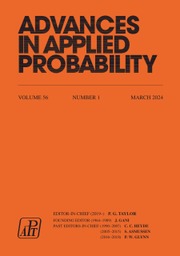No CrossRef data available.
Article contents
Steady-state Dirichlet approximation of the Wright-Fisher model using the prelimit generator comparison approach of Stein’s method
Published online by Cambridge University Press: 27 May 2025
Abstract
The Wright–Fisher model, originating in Wright (1931) is one of the canonical probabilistic models used in mathematical population genetics to study how genetic type frequencies evolve in time. In this paper we bound the rate of convergence of the stationary distribution for a finite population Wright–Fisher Markov chain with parent-independent mutation to the Dirichlet distribution. Our result improves the rate of convergence established in Gan et al. (2017) from  $\mathrm{O}(1/\sqrt{N})$ to
$\mathrm{O}(1/\sqrt{N})$ to  $\mathrm{O}(1/N)$. The results are derived using Stein’s method, in particular, the prelimit generator comparison method.
$\mathrm{O}(1/N)$. The results are derived using Stein’s method, in particular, the prelimit generator comparison method.
MSC classification
Information
- Type
- Original Article
- Information
- Copyright
- © The Author(s), 2025. Published by Cambridge University Press on behalf of Applied Probability Trust
References
Barbour, A. (1990). Stein’s method for diffusion approximations. Probab. Theory and Related Fields 84, 297–322.CrossRefGoogle Scholar
Barbour, A. D. (1988). Stein’s method and Poisson process convergence. J. Appl. Probab. 175–184. A celebration of applied probability.CrossRefGoogle Scholar
Barbour, A. D. and Chen, L. H. Y. (eds) (2005).
An Introduction to Stein’s Method. (Lecture Notes Series, Institute for Mathematical Sciences, National University of Singapore 4). Singapore University Press, Singapore; World Scientific Publishing Co. Pte. Ltd., Hackensack, NJ. Lectures from the Meeting on Stein’s Method and Applications: a Program in Honor of Charles Stein held at the National University of Singapore, Singapore, July 28–August 31, 2003.Google Scholar
Barbour, A. D., Holst, L. and Janson, S. (1992). Poisson Approximation (Oxford Studies in Probability 2). The Clarendon Press, Oxford University Press, Oxford Science Publications, New York.CrossRefGoogle Scholar
Braverman, A. (2022). The prelimit generator comparison approach of Stein’s method. Stochastic Systems 12, 181–204.CrossRefGoogle Scholar
Braverman, A. (2023). The join-the-shortest-queue system in the Halfin-Whitt regime: Rates of convergence to the diffusion limit. Stochastic Systems 13, 1–39.CrossRefGoogle Scholar
Brown, T. C. and Phillips, M. J. (1999). Negative binomial approximation with Stein’s method. Methodol. Comput. Appl. Probab. 1, 407–421.CrossRefGoogle Scholar
Chatterjee, S. (2014). A short survey of Stein’s method. In Proceedings of the International Congress of Mathematicians—Seoul 2014, Vol. IV. Kyung Moon Sa, Seoul. pp. 1–24.Google Scholar
Chen, L. H. Y. (1975). Poisson approximation for dependent trials. Ann. Probab. 3, 534–545.CrossRefGoogle Scholar
Döbler, C. (2015). Stein’s method of exchangeable pairs for the beta distribution and generalizations. Electron. J. Probab. 20, no. 109, 34.CrossRefGoogle Scholar
Ethier, S. N. and Norman, M. F. (1977). Error estimate for the diffusion approximation of the Wright–Fisher model. Proceedings of the National Academy of Sciences 74, 5096–5098.CrossRefGoogle Scholar
Fulman, J. and Ross, N. (2013). Exponential approximation and Stein’s method of exchangeable pairs. ALEA Lat. Am. J. Probab. Math. Stat. 10, 1–13.Google Scholar
Gan, H. L., Röllin, A. and Ross, N. (2017). Dirichlet approximation of equilibrium distributions in Cannings models with mutation. Adv. in Appl. Probab. 49, 927–959.CrossRefGoogle Scholar
Gan, H. L. and Ross, N. (2021). Stein’s method for the Poisson-Dirichlet distribution and the Ewens sampling formula, with applications to Wright-Fisher models. Ann. Appl. Probab. 31, 625–667.CrossRefGoogle Scholar
Goldstein, L. and Reinert, G. (2013). Stein’s method for the beta distribution and the Pólya-Eggenberger urn. J. Appl. Probab. 50, 1187–1205.CrossRefGoogle Scholar
Kasprzak, M. J. (2017). Diffusion approximations via Stein’s method and time changes. Preprint. Available at https://arxiv.org/abs/1701.07633.Google Scholar
Ley, C., Reinert, G. and Swan, Y. (2017). Stein’s method for comparison of univariate distributions. Probability Surveys 14, 1–52.CrossRefGoogle Scholar
Mackey, L. and Gorham, J. (2016). Multivariate Stein factors for a class of strongly log-concave distributions. Electron. Commun. Probab. 21, 14.Google Scholar
Stein, C. (1972). A bound for the error in the normal approximation to the distribution of a sum of dependent random variables. In Proceedings of the Sixth Berkeley Symposium on Mathematical Statistics and Probability (University of California, Berkeley, CA, 1970/1971), Vol. II: Probability theory. University California Press, Berkeley, CA, pp. 583–602.CrossRefGoogle Scholar
Stroock, D. W. and Varadhan, S. R. S. (1979). Multidimensional Diffusion Processes. Springer, New York.Google Scholar


